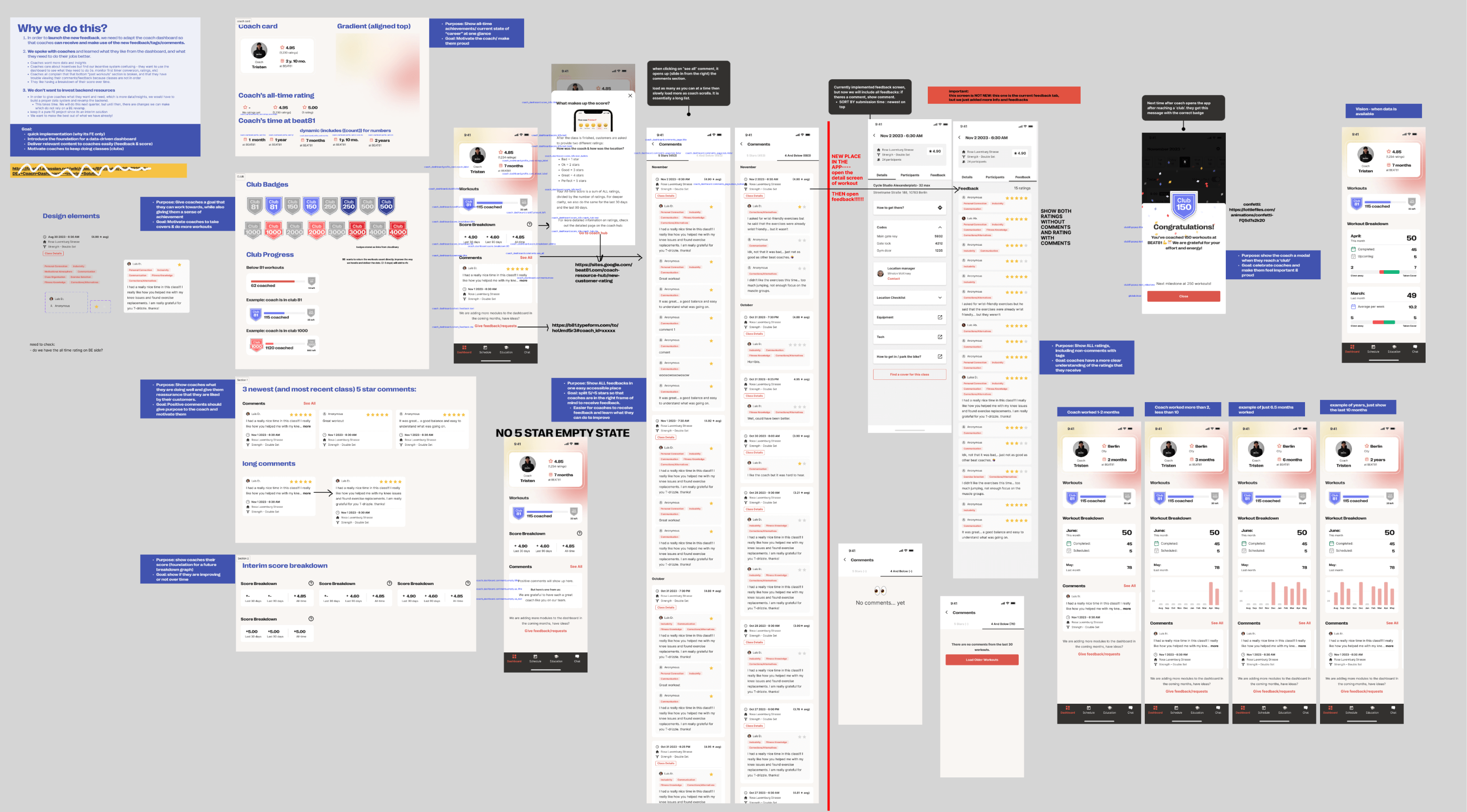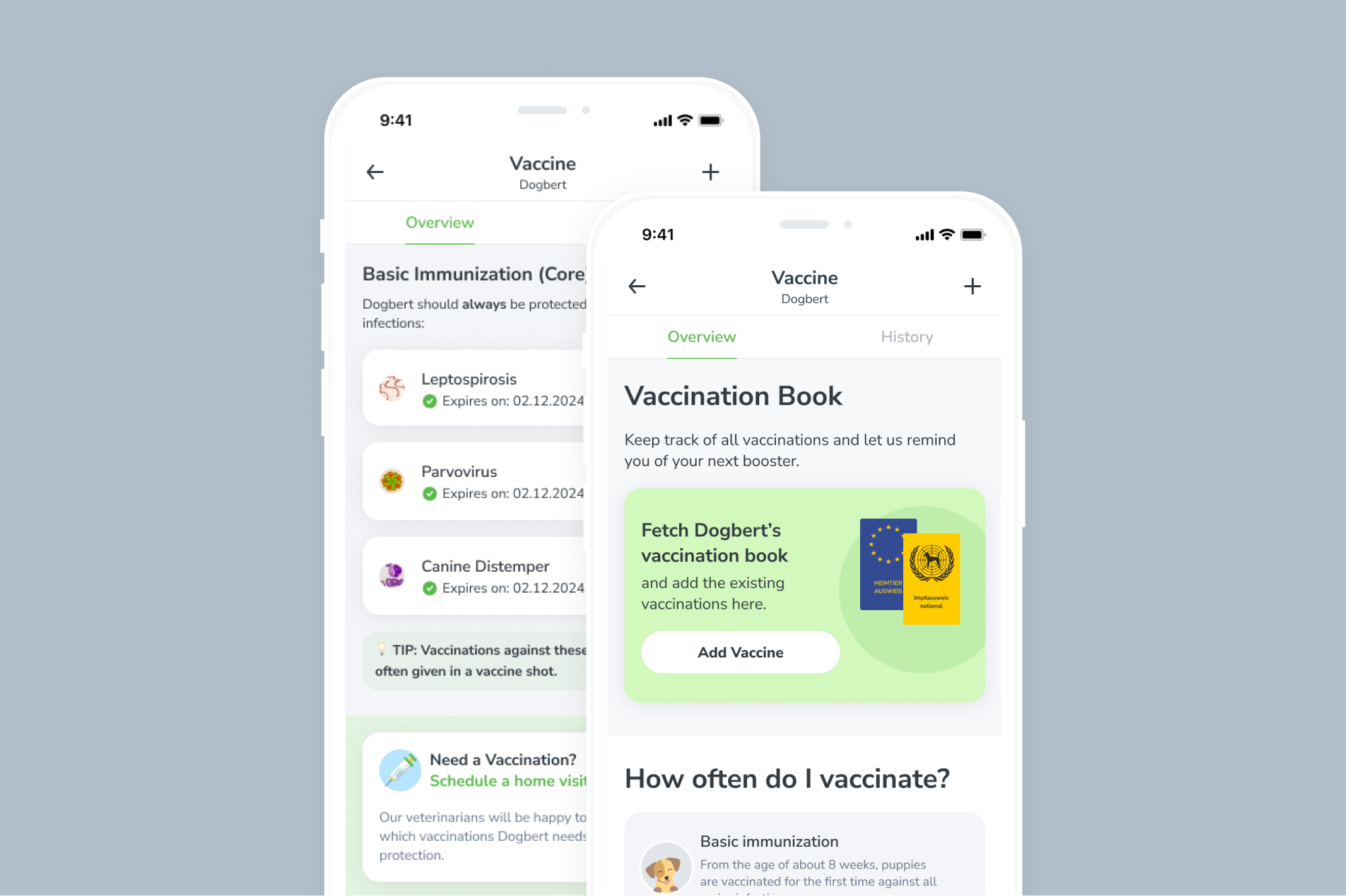
Background
Challenge: Coach Dashboard Reimagination
Existing Problem:
- Deprecated star rating system left dashboard functionally empty
- No meaningful performance feedback mechanism
- Limited value proposition for coaches
- Technical constraints on backend resource utilizatiom
Design Constraints:
- Deliver actionable insights
- Minimize backend complexity
- Create engaging user experience
- Enable future system extensibility
Solution
Strategic Approach:
- Comprehensive visual redesign of primary app interface
- Modular component architecture supporting future enhancements
- Introduced motivational design elements through gamification mechanics and personalization features
Key Design Innovations:
- Gamification Elements: reward system, achievement badges
- Personalization: custom profile imagery, workout history tracking
- Scalable Interface Design: flexible layout for future integrations, potential for additional metrics (e.g., earnings)
Company
BEAT81
BEAT81 runs hundreds of spin and group HIIT classes a day throughout Germany; what makes BEAT81 special is the integration of technology to add guidance & personalisation.
Participants wear a heart-rate sensor and see their maximum heart rate percentage LIVE throughout the entire workout.
Role (Full time Senior Product Designer)
- Product Vision & Concept
- Research
- Tech Prioritisation
- UX Design
- Copywriting (English)
- UI Design
Understanding the Status Quo
Coach dashboard pre redesign
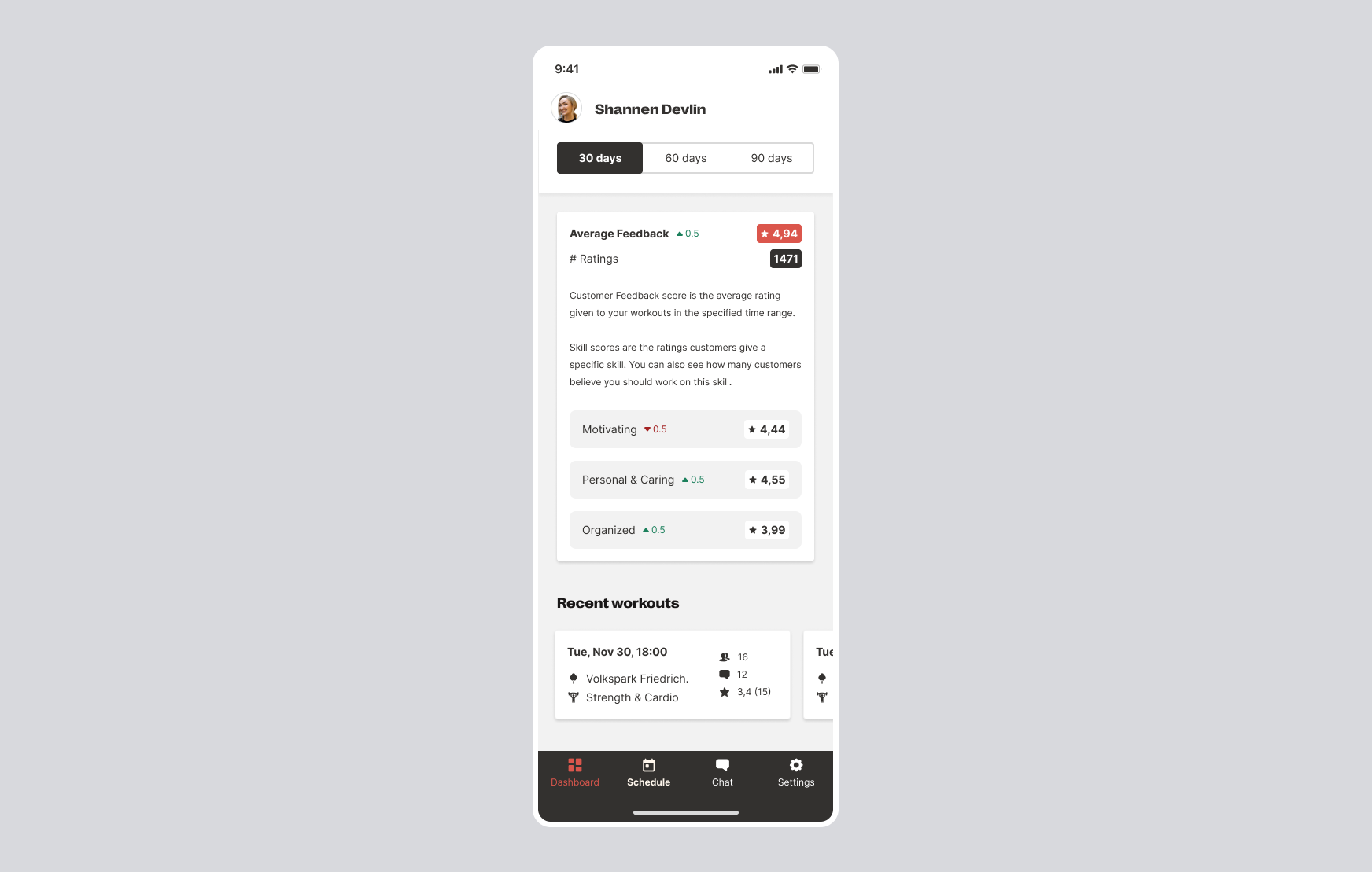
Interviews with coaches to uncover both the strengths of the existing dashboard and critical gaps in its functionality.
1.
They like the ‘feeling’ of progress
-
While the 30/60/90 day rating breakdown offered coaches insights into performance trajectories and potential improvement areas, the system was discontinued.
-
Extensive coach feedback revealed that numerical ratings generated significant psychological strain, negatively impacting mental well-being and professional confidence.
2.
Lacking quick access to customer feedback
- Customer feedback represents a critical communication channel for coaches, yet the current interface obstructs meaningful insight retrieval. Coaches must navigate a convoluted multi-step process: first selecting a workout from an unsorted carousel, then drilling through additional screens to ultimately access customer comments.
- This complex interaction design creates significant friction, effectively discouraging coaches from engaging with valuable performance feedback and hindering their professional development.
3.
Lacking useful metrics
- The existing dashboard is fundamentally misaligned with BEAT81’s comprehensive coach evaluation methodology. Despite its title, the interface currently offers only a limited and potentially harmful rating breakdown—a metric slated for complete removal due to its negative psychological impact.
- In reality, coach performance is evaluated through nuanced, meaningful indicators: coverage acceptance rates, first-time client conversion success, and monthly coaching volume, which directly inform compensation and professional recognition.
Hypothesis
The core benefit is that enhancing the coach-facing tools and insights will have a downstream positive impact on the customer experience. Investing in the coach dashboard supports the long-term growth and retention of the coaching staff, which directly benefits BEAT81’s clients.
Starting the Process
I began by looking at what other apps are doing – just to get my creative juices flowing.
Bridging creative thinking with creative potential
Design Research Evolution: Modern digital design tools have transformed competitive analysis from a manual, time-consuming process to a streamlined exploration.
Platforms like Mobbin enable rapid access to curated UI libraries, allowing designers to efficiently generate inspiration mood boards and share insights with team members.
While premature visual design research can be restrictive, this early phase serves a critical function—creating mental frameworks and conceptual sketches that subtly inform the entire design journey.
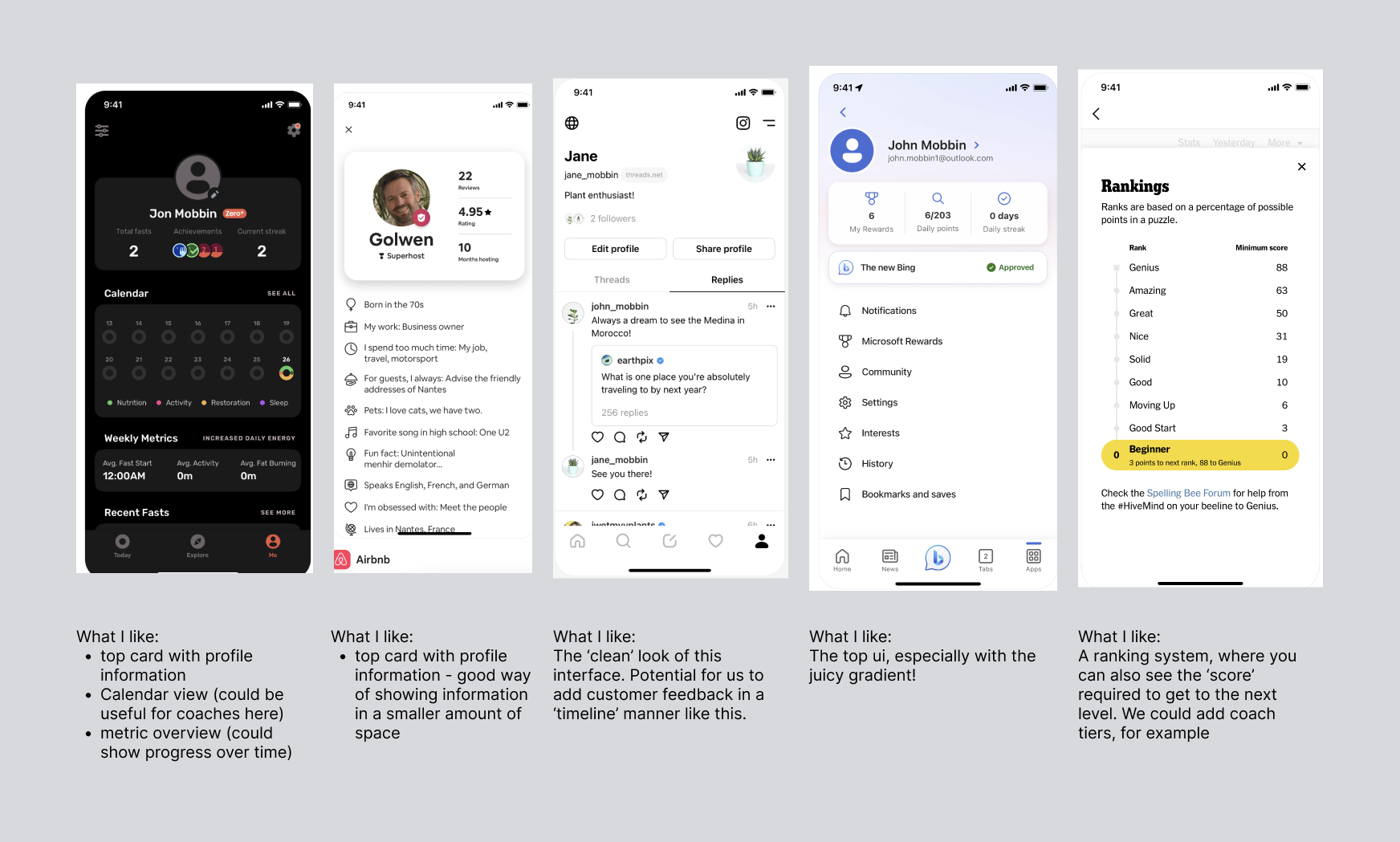
Brainstorming & Direction Decisions
Exploration
With a clear objective to replace the existing dashboard with a more nuanced feedback and metric mechanism, I leveraged Figjam for collaborative brainstorming.
This generative process involved rapidly collecting potential concepts, followed by a critical review with the product team. Their insights and constructive feedback served as a catalyst, enriching the initial ideas and expanding the conceptual landscape for the dashboard redesign.
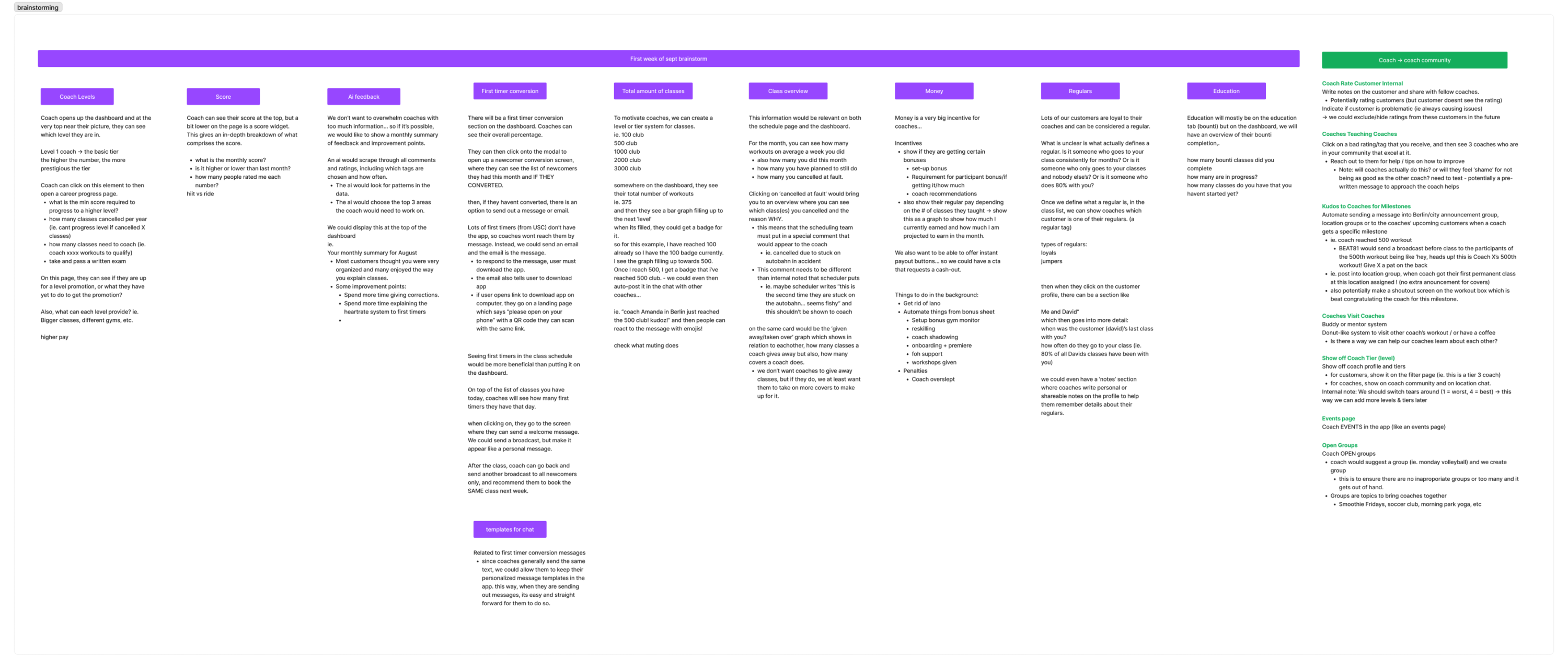

Coaches have an appetite for professional insight
Recognizing coaches’ appetite for deeper professional insights, I developed a strategic research plan centered on a purposefully crafted survey. The objective was to uncover the critical metrics and feedback mechanisms most valued by coaches, moving beyond superficial rating systems to a more meaningful understanding of their performance and developmental needs.
Key Findings:
- Coaches want more data and insights
- Coaches care about incentives but find our incentive system confusing – they want to use the dashboard to see what they need to do (ie. monitor first timer conversion, ratings, etc)
- Coaches all complain that that bottom “past workouts” section is broken, and that they have trouble viewing their comments/feedback because classes are not in order
- They like having a breakdown of their score over time.
UX Strategy
Vision and creative exploration, not thinking about feasibility and tech capacity (yet)
Turning learnings into a concept
Embracing a vision-first approach, I initiated the dashboard design by deliberately suspending technical constraints.
The goal was to craft an aspirational 11-star experience that fully realized the potential of coach insights.
By removing implementation limitations from the initial creative process, I aimed to establish a comprehensive conceptual framework from which we could strategically derive a minimum viable product (MVP) that maintains the core design integrity.

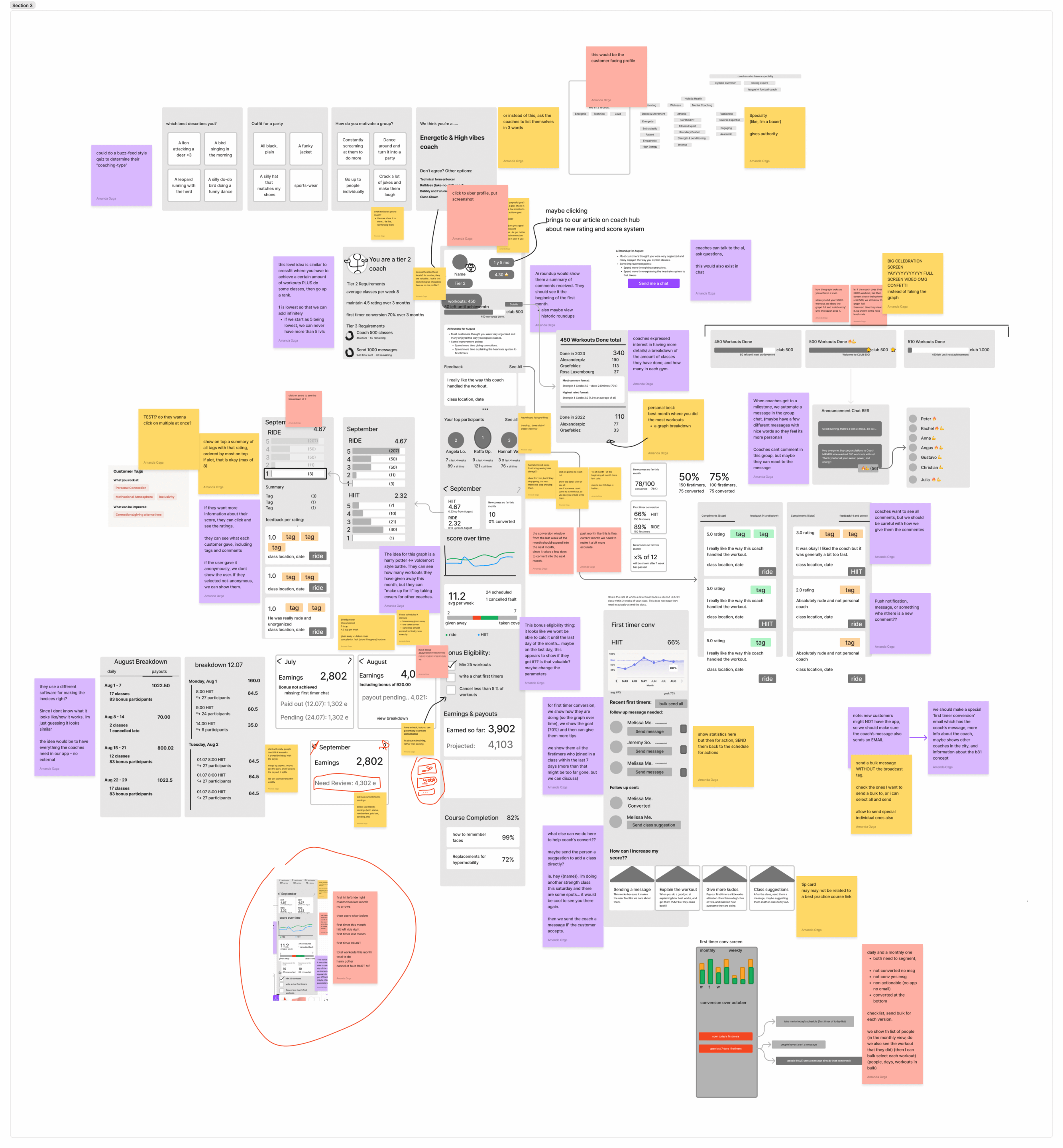
Not the final design, but rather, one of many design iterations:

Notes and revisions
Recognizing the inherent limitations of individual perspective, I adopted a holistic, participatory design approach. Through targeted workshops with coaches and internal stakeholders, I systematically challenged my own assumptions and biases.
This inclusive methodology prioritized empathy and active listening, transforming the design process into a collective exploration that leveraged diverse insights and experiences to create a more authentic, user-centered solution.
The 11 star experience
- Personalized profile with intrinsic goal-setting (tracked workout coaching progression)
- Immediate and accessible customer feedback mechanism
- Visualization of most frequent clients to foster relationship-building
- Comprehensive metrics dashboard with drill-down capabilities, covering performance indicators like ratings and first-time client conversion
- Visual earnings representation with integrated coaching incentive structures
The design transforms performance tracking into a motivational, self-directed professional development journey.
Solution
Strategic Scoping and MVP Development
Inspired coaches are the key to exceptional class experiences
Following our comprehensive wireframe, we ruthlessly prioritized features, focusing on what could be rapidly implemented with minimal backend effort.
The design converged on two core objectives: customer feedback accessibility and coach motivation.
By creating a streamlined interface that provides meaningful insights, we recognized that inspired coaches are the key to exceptional class experiences, transforming the dashboard into a tool for professional growth and continuous improvement.
I like to add a “why we do this” section. This approach ensures that every team member comprehends the broader vision, fostering alignment and motivation even when navigating complex design and technical constraints. Regularly articulating our core mission prevents teams from becoming myopically focused on isolated technical details, instead keeping the transformative user experience at the heart of our work.
What Made the Cut:
Motivation and Achievement Design
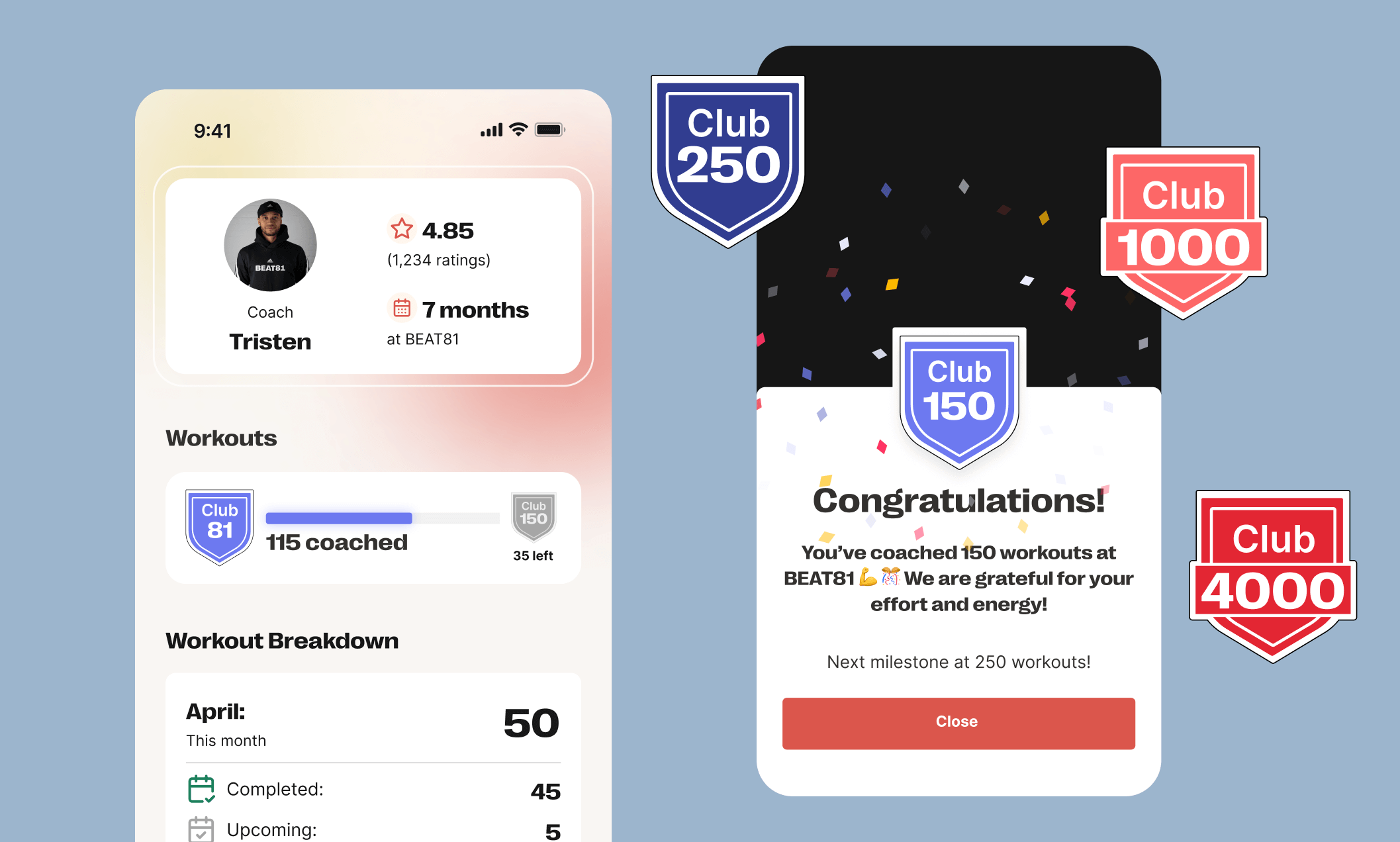
Positive Feedback Prioritization Strategy
- Intentionally surfaced only positive customer comments to protect coaches’ mental health
- Designed an initial view that primes coaches with affirming feedback
- Provided optional drill-down capability for comprehensive comment exploration
- Created a psychologically supportive interface that balances transparency with emotional well-being

Monthly Workout Tracking Feature
- Addressed critical pain point for freelance coaches: manual invoice preparation
- Implemented a streamlined monthly workout counter to simplify workout count tracking
- Demonstrated commitment to improving coaches’ operational efficiency through targeted design solution


Where we started

Where we ended up (for now)
Conclusion & Learnings
I didn’t expect to relate so deeply to the coach experience – but this realisation was the key
Design Without Limits: If I had worried about technical constraints from the start, I would have never let my creativity truly run wild. My approach? Love your darlings, then fearlessly kill them. I loved every feature or idea and fueled that love into generating more ideas – but when the time came to scope down, I let my darlings be cut.
Coach feedback was pure gold. Sure, everyone talks about the importance of user input, but for me, it was more personal. I had to push past my perfectionist tendencies and learn to share imperfect work with the coaches. It’s tough – even after years of design experience, showing something you’ve poured your heart into can feel vulnerable.
This journey made me realize something important: coaches face the same challenge.
They pour their soul into every class, and then anyone can drop a comment/critique. My goal was simple: create a dashboard that feels supportive, that sees coaches as real people with real needs. Not just a tool, but a companion in their professional growth.


